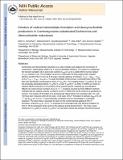Kinetics of radical intermediate formation and deoxynucleotide production in 3-aminotyrosine-substituted Escherichia coli ribonucleotide reductases
Author(s)
Minnihan, Ellen Catherine; Seyedsayamdost, Mohammad R.; Uhlin, Ulla; Stubbe, JoAnne
DownloadStubbe_Kinetics of.pdf (2.201Mb)
PUBLISHER_POLICY
Publisher Policy
Article is made available in accordance with the publisher's policy and may be subject to US copyright law. Please refer to the publisher's site for terms of use.
Terms of use
Metadata
Show full item recordAbstract
Escherichia coli ribonucleotide reductase is an α2β2 complex and catalyzes the conversion of nucleoside 5′-diphosphates (NDPs) to 2′-deoxynucleotides (dNDPs). The reaction is initiated by the transient oxidation of an active-site cysteine (C[subscript 439]) in α2 by a stable diferric tyrosyl radical (Y[subscript 122]•) cofactor in β2. This oxidation occurs by a mechanism of long-range proton-coupled electron transfer (PCET) over 35 Å through a specific pathway of residues: Y[subscript 122]•→ W[subscript 48]→ Y[subscript 356] in β2 to Y[subscript 731]→ Y[subscript 730]→ C[subscript 439] in α2. To study the details of this process, 3-aminotyrosine (NH[subscript 2]Y) has been site-specifically incorporated in place of Y[subscript 356] of β. The resulting protein, Y[subscript 356]NH[subscript 2]Y-β2, and the previously generated proteins Y[subscript 731]NH[subscript 2]Y-α2 and Y[subscript 730]NH[subscript 2]Y-α2 (NH[subscript 2]Y-RNRs) are shown to catalyze dNDP production in the presence of the second subunit, substrate (S), and allosteric effector (E) with turnover numbers of 0.2–0.7 s[superscript –1]. Evidence acquired by three different methods indicates that the catalytic activity is inherent to NH[subscript 2]Y-RNRs and not the result of copurifying wt enzyme. The kinetics of formation of 3-aminotyrosyl radical (NH[subscript 2]Y•) at position 356, 731, and 730 have been measured with all S/E pairs. In all cases, NH[subscript 2]Y• formation is biphasic (k[subscript fast] of 9–46 s[superscript –1] and k[subscript slow] of 1.5–5.0 s[subscript –1]) and kinetically competent to be an intermediate in nucleotide reduction. The slow phase is proposed to report on the conformational gating of NH[subscript 2]Y• formation, while the k[subscript cat] of 0.5 s[superscript –1] is proposed to be associated with rate-limiting oxidation by NH[subscript 2]Y• of the subsequent amino acid on the pathway during forward PCET. The X-ray crystal structures of Y[subscript 730]NH[subscript 2]Y-α2 and Y[subscript 731]NH[subscript 2]Y-α2 have been solved and indicate minimal structural changes relative to wt-α2. From the data, a kinetic model for PCET along the radical propagation pathway is proposed.
Date issued
2011-05Department
Massachusetts Institute of Technology. Department of Biology; Massachusetts Institute of Technology. Department of ChemistryJournal
Journal of the American Chemical Society
Publisher
American Chemical Society (ACS)
Citation
Minnihan, Ellen C. et al. “Kinetics of Radical Intermediate Formation and Deoxynucleotide Production in 3-Aminotyrosine-Substituted Escherichia Coli Ribonucleotide Reductases.” Journal of the American Chemical Society 133.24 (2011): 9430–9440.
Version: Author's final manuscript
ISSN
0002-7863
1520-5126